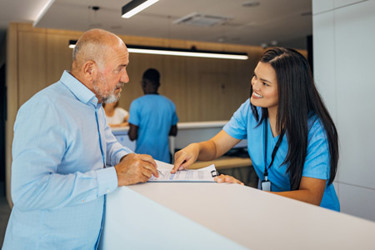The Hidden Power Of Specialized Community Research Sites In Accelerating Clinical Trials
By G. Aaron DuVall, MD, founder and principal investigator, Tyler Research Institute

The pace of drug development today is dictated not only by science but also by the speed at which trials are executed. Clinical trial sponsors and CROs invest significant resources in recruiting new study centers. Yet, the average location takes over six months to get activated on a study, and fewer than half of those engaged enroll even a single patient. The sustainability of this research model is in jeopardy, with two-thirds of principal investigators (PIs) participating in just one trial before leaving — a persistent trend over the past decade.
For people suffering from gastrointestinal conditions like Crohn’s disease and ulcerative colitis (UC), time is critical, as taking months or even years for a new therapy to reach patients. Specialized community-based research sites are uniquely positioned to address this bottleneck. By embedding within the medical community, offering access to diverse patient populations, and building processes tailored for chronic disease care, these sites can accelerate timelines and improve outcomes. This approach will deliver cutting-edge therapies more quickly, while keeping care closer to home.
Accelerating Enrollment Through Readiness
In clinical research, time is everything. From the moment a therapy is patented, the clock begins ticking down to recoup the R&D investment before the patent expires, and clinical trials consume the majority of that window.
One key factor for quickly randomizing patients into a new trial is to be nimble in obtaining site approval and preparing for the initial screening. Recently, TRI screened six patients in the first two weeks post-activation in a recent Phase 2 inflammatory bowel disease (IBD) trial — starkly different from industry benchmarks of >75 days. This accelerated efficient activation process is driven by an integrated team of specialized on-site experts (regulatory, quality, accounting) and embedded operational resources that provide scalable infrastructure and ensure consistent study readiness across trials.
The impact is measurable. For example, the county where TRI is located has a population of approximately 110,000 people. Within the past few months, TRI has randomized over 100 patients across a dozen IBD Phase 2-3 trials, achieving screen fail rates of less than 15%. Those numbers are the result of patient access, disciplined processes, and highly engaged site staff.
The stakes for accelerating research are not theoretical and extend beyond impact on sponsors. As physicians, we are in the trenches with patients with chronic diseases who are desperate for new treatment options, and delays have real human costs.
Clinical Trial Access For Underserved Populations
Community clinics need to become an integral part of their local medical community. By building trust locally, they can engage patients who may otherwise lack access to specialty care. In this setting, clinical research becomes a care option.
One of the most underappreciated assets of a clinical research program is that it provides a treatment avenue for underprivileged patients. Currently, the only viable options for IBD are biological therapies, which are extremely cost-prohibitive for uninsured or underinsured patients. By hosting clinical trials in a community setting, successful treatment options can be provided to patients who have previously been trapped in a cycle of multiple hospital and ER admissions for their uncontrolled and untreated IBD. This removes financial liability from the medical community, but more importantly, provides an avenue for successful treatment and remission for patients with chronic diseases that previously had no hope of accessing new treatment opportunities.
The impact of clinical research is often best illustrated through individual patient experiences. One such example at TRI involves a woman with a 17-year history of severe left-sided ulcerative colitis. Since enrolling in a clinical trial at our site, she has experienced marked improvement in her condition, enabling her to return to school, earn her teaching certification, and begin working full time in her local school district. She is once again able to be involved in her children’s activities and enjoy life to the fullest. Her journey demonstrates how trials conducted in community clinics can deliver both clinical and socioeconomic transformation.
Trust And Longitudinal Care
Nowhere are the advantages of community-based research more visible than in patient outcomes. IBD is a chronic disease that requires lifelong therapy. However, for Crohn’s and UC, current therapies deliver one-year remission rates of only 30%–50%. Many IBD patients also fail more than one commercially available therapy. For these patients, clinical trials are a lifeline.
The nature of chronic diseases requires the fostering of trust and dedication in the patient’s healthcare provider relationship. Many clinical trials span multiple years. Therefore, the continuity of care provided by a research team must be strong enough to weather the inevitable successes and failures in treating such refractory diseases. Physicians help carry their patients’ burdens and become like an extended family.
This type of longitudinal support translates into higher retention rates, cleaner data, and more predictable outcomes — all of which improve the efficiency of trials.
Infrastructure That Enables Scale
Scaling community research requires more than clinical expertise and physician dedication. The most important factor in the growth of a clinical community site is implementing a business model that is scalable and sustainable. This includes finances, quality/regulatory compliance, employee training and retention, and study opportunities, all facilitated by successful contract negotiation. Without this foundation, even the most committed physicians cannot enroll at scale or deliver consistent, high-quality data.
At TRI, this barrier has been addressed through collaboration with a research network that consolidates and strengthens key operational functions. Our site is now able to support dedicated regulatory and laboratory staff, multiple coordinators, and both blinded and unblinded pharmacists — resources that many independent community sites lack. This integrated structure provides the full range of expertise necessary for efficient, high-quality trial execution. It enables parallel workflows, reduces handoffs, and ensures clear accountability throughout the study life cycle. This collaborative approach emphasizes site performance, growth, and sustainability, allowing TRI to maintain focus on delivering strong clinical outcomes and patient-centered research.
Sponsors also play a key role in unlocking the full potential of community-based research. Too often, resources are spread thin across low-enrolling investigators. Across the U.S., the average recruitment rate is only 0.4 to 0.7 patients per site, which does not justify the investment and slows trial progress. The system must be retooled to concentrate resources on high-volume community programs that are organized, well supported, and capable of delivering both the speed and data quality that trials require.
The benefits for sponsors are clear. Partnering with strong community networks reduces the need to contract and monitor dozens of low-volume sites. Instead, sponsors gain access to practices with patients who are waiting to enroll. Administrative burden is lessened while start-up and recruitment are accelerated. As trial demand grows and the shortage of trained PIs increases, sites must be selective in the studies they take on. Networks that empower community practices will be critical to scaling responsibly, demonstrating early success, and laying the foundation for long-term transformation.
The Future Of Community-Based Research
As academic centers struggle with inefficiencies, specialized community sites are gaining popularity because they are nimble and equipped to deliver volume and quality at speed. By embedding within communities, building trust with patients, and structuring operations for efficiency, these programs are addressing one of the industry’s most persistent bottlenecks.
The future of efficient research also depends on the commitment of sponsors. Rather than stretching bandwidth to contract and monitor dozens of low-volume sites, sponsors should partner with high-performing networks that support and equip community practices at scale.
The hidden power of this model lies in its ability to shorten timelines, improve data quality, and expand access to deliver life-changing therapies to patients faster and more effectively. At Tyler Research Institute, we’ve seen how community-based research turns that efficiency into impact by meeting patients where they are and transforming access to innovation into access to healing.
About The Author:
 G. Aaron DuVall is a gastroenterologist in Tyler, Texas, affiliated with CHRISTUS Health, Trinity Clinic, and conducts research at the Tyler Research Institute, a subsidiary of Iterative Health. He attended medical school and completed his residency at the Baylor College of Medicine. Following his residency, he completed his GI fellowship at UTMB and then subspecialized in advanced therapeutic endoscopy and endoscopic oncology at the University of Toronto in 1997. Dr. DuVall has been in practice for over 28 years and has led numerous gastrointestinal clinical trials, contributing to the advancement of new diagnostic and therapeutic approaches. He is also a lead PI consultant with Iterative Health, supporting efforts to improve the clinical trial process in gastroenterology.
G. Aaron DuVall is a gastroenterologist in Tyler, Texas, affiliated with CHRISTUS Health, Trinity Clinic, and conducts research at the Tyler Research Institute, a subsidiary of Iterative Health. He attended medical school and completed his residency at the Baylor College of Medicine. Following his residency, he completed his GI fellowship at UTMB and then subspecialized in advanced therapeutic endoscopy and endoscopic oncology at the University of Toronto in 1997. Dr. DuVall has been in practice for over 28 years and has led numerous gastrointestinal clinical trials, contributing to the advancement of new diagnostic and therapeutic approaches. He is also a lead PI consultant with Iterative Health, supporting efforts to improve the clinical trial process in gastroenterology.
